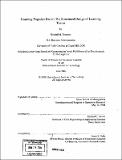Learning together better : the structured design of learning teams
Author(s)
Timmers, Kendell M. (Kendell MacQueen), 1978-
DownloadFull printable version (5.226Mb)
Other Contributors
Massachusetts Institute of Technology. Operations Research Center.
Advisor
Richard C. Larson.
Terms of use
Metadata
Show full item recordAbstract
There is a great need among educators for a way to quickly assign teams in large or distance learning classrooms in a manner superior to random assignment or student self-selection. Forming teams based on knowledge of students' characteristics is too time-consuming for large classrooms, yet research has shown that the characteristics of individuals greatly affect the quality of the teamwork experience. This thesis provides an automated method to quickly assign students to teams based on individual characteristics. We begin with a thorough review of the literature on how individuals' characteristics affect team behavior, focusing on the level of diversity of four main classes of traits - knowledge/skills/abilities, demographics, personality, and motivation. By forming teams that have diversity on some of these traits and homogeneity on others, we will be able to improve performance over randomly assigned teams. We frame this problem from a group dynamics perspective, measuring the compatibility of every dyad of students within a team. We propose, for several group environments, which traits should be homogeneous and which heterogeneous, and how important each trait is, and use these values to create an equation for a student compatibility score, a number representing how well a pair of students will work together. We then simulate team assignment to determine which of several heuristics is most efficient. A combination of random generation and pairwise exchange is found to be the best, forming teams with average compatibilities 307% higher than the average randomly generated team. The code for this program is included in the appendices. (cont.) Additionally, we perform a classroom experiment in which sections of a class are divided into teams by three different methods - random assignment, intuition, and the method devised above. Although the experimental design was flawed, the results were encouraging, demonstrating that average student compatibility on a team was significantly positively associated with both the resulting team grade and the students' perception of how much they learned about teamwork. For a more detailed executive summary of this work, please see the Structure of the Thesis section on page 16.
Description
Thesis (S.M.)--Massachusetts Institute of Technology, Sloan School of Management, Operations Research Center, 2004. Includes bibliographical references (p. 105-110).
Date issued
2004Department
Massachusetts Institute of Technology. Operations Research Center; Sloan School of ManagementPublisher
Massachusetts Institute of Technology
Keywords
Operations Research Center.